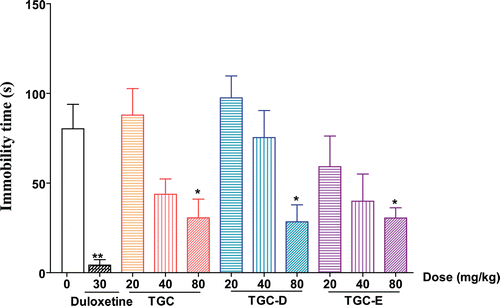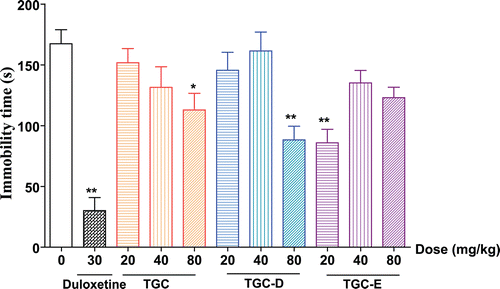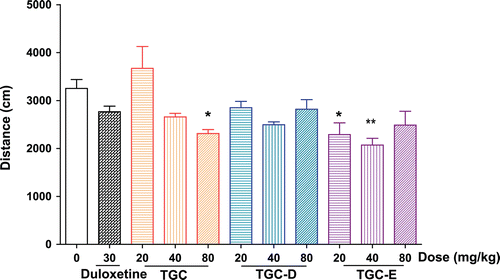Figures & data
Figure 1. Effects of TGC, TGC-D and TGC-E on the immobility time of mice in the tail suspension test. Mice were orally given TGC, TGC-D and TGC-E (20, 40 and 80 mg/kg) or vehicle (0.5% CMC-Na) for 5 consecutive days, respectively. Tail suspension test were carried out 1 h after last administration on the 5th day. Data are presented as mean ± SEM, n = 10. *p< 0.05, significance versus vehicle control.

Figure 2. Effects of TGC, TGC-D and TGC-E on the immobility time of mice in the forced swimming test. Mice were orally given TGC, TGC-D and TGC-E (20, 40 and 80 mg/kg) or vehicle (0.5% CMC-Na) for 5 consecutive days, respectively. Forced swimming test were carried out 1 h after last administration on the 5th day. Data are presented as mean ± SEM, n = 10. *p < 0.05 and **p < 0.01, significance versus vehicle control.

Figure 3. Effects of TGC, TGC-D and TGC-E on the crossing distances of mice in the locomotor activity test. Mice were orally given TGC, TGC-D and TGC-E (20, 40 and 80 mg/kg) or vehicle (0.5% CMC-Na) for 5 consecutive days, respectively. Locomotor activity test were carried out 1 h after last administration on the 5th day. Data are presented as mean ± SEM, n = 10. *p < 0.05 and **p < 0.01, significance versus vehicle control.

Figure 4. The inhibitory effects of TGC, TGC-D and TGC-E on [3H]-serotonin reuptake in rat brain synaptosomes. TGC, TGC-D and TGC-E were tested at dose of 0.001, 0.01, 0.1, 1.0, and 10 mg/L; while duloxetine were tested at dose of 0.00033 mg/L (10−9 mol/L), 0.0033 mg/L (10−8 mol/L), 0.033 mg/L (10−7 mol/L), 0.33 mg/L (10−6 mol/L), and 3.3 mg/L (10−5 mol/L).
![Figure 4. The inhibitory effects of TGC, TGC-D and TGC-E on [3H]-serotonin reuptake in rat brain synaptosomes. TGC, TGC-D and TGC-E were tested at dose of 0.001, 0.01, 0.1, 1.0, and 10 mg/L; while duloxetine were tested at dose of 0.00033 mg/L (10−9 mol/L), 0.0033 mg/L (10−8 mol/L), 0.033 mg/L (10−7 mol/L), 0.33 mg/L (10−6 mol/L), and 3.3 mg/L (10−5 mol/L).](/cms/asset/a53f525d-bc14-429d-bfe7-6194c93c1aa6/iphb_a_656848_f0004_b.gif)